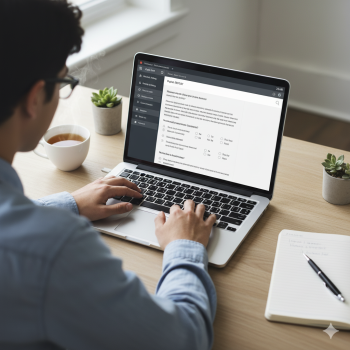Why Skimming Feels Smart — and Why It Can Backfire on the Digital SAT
You’ve probably heard the advice a thousand times: “Skim the passage first, then answer the questions.” It sounds efficient. You save time, you get the gist, and you move on. On paper SATs, that tactic sometimes produced acceptable results — for certain students and certain passages. But the Digital SAT has changed the terrain. Skimming now carries more risk than ever, because the test design, question style, and the way you interact with text on a screen change what a “quick read” actually gets you.
This blog walks you through why skimming is risky on the Digital SAT Reading section, how small misunderstandings can cost you big in a computerized environment, and practical, student-friendly strategies you can use instead. I’ll toss in examples, a short comparison table, and realistic practice tips you can start using today. And if you want a faster shortcut to improvement, I’ll explain when working with a personalized tutor — such as Sparkl’s 1-on-1 guidance with tailored study plans and AI-driven insights — can accelerate progress without teaching bad habits.
The Digital Difference: Why Screen Reading Changes Everything
1. Layout and Navigation
On a digital screen you don’t get a full visible page like you do on paper. You see a portion of the passage at a time, you scroll or move between passage panels, and the interface may highlight or show question-stem context differently. That changes the way we form a mental map of the passage. With less simultaneous visual context, skimming can leave gaps in how you connect ideas.
2. Question Types that Reward Precision
The Digital SAT emphasizes evidence-based questions, fine-grained inference, and precise wording. Many questions hinge on a single word in a sentence or the relationship between two short phrases. When you skim, it’s easy to miss those words — and those missed words often change the correct answer.
3. Shorter, Denser Passages
Some digital passages are shorter but denser, trading long narrative stretches for concentrated argument or analysis. A skim that captures the “big idea” might miss the author’s qualifying phrase, a pivot like “however” or “instead,” or an embedded counterexample — all of which can determine answer choice correctness.
Concrete Ways Skimming Leads to Mistakes
- Misreading qualifiers: Words like “rarely,” “typically,” “often,” “however,” and “nevertheless” flip meaning. A skimmer might treat a sentence as endorsing a claim when it’s actually undermining it.
- Overlooking text evidence: Evidence-support questions require pairing answer choices with explicit phrases. If you only skim, you’ll pick answers that sound right but lack textual backing.
- Mistaking tone and purpose: Tone questions reward subtle reading of diction and syntax, not just the topic. Fast skimming flattens tone into a bland, neutral sense of the passage.
- Confusing referents and pronouns: When you skim, you might lose track of who “they,” “this,” or “that” refer to, especially across paragraph breaks.
An Example (Keep It Practical)
Imagine a 1-paragraph passage arguing that a popular educational reform has only modest effects because of systemic funding issues. A skimmer might register “reform doesn’t work” and answer a question asking the author’s stance as “opposed to reform.” But the author may actually support reform while arguing it must be paired with funding changes—so the correct answer is nuanced, something like “supports reform but cautions that funding is essential.” The nuance is easy to miss when skimming.
When (If Ever) Skimming Can Work — and When to Avoid It
Good moments for a quick skim
Skimming can be useful as a triage tool: when you’re scanning to decide which passage to tackle first, a fast read can help you pick a passage that matches your strengths (e.g., a narrative vs. a science passage). Use a 30–45 second skim only to decide order — not to answer questions.
Bad moments to skim
- When questions ask for the specific meaning of a phrase or word.
- When evidence-in-passage is required.
- When tone, purpose, or the author’s attitude is being tested.
- When you are already scoring close to your target and small errors matter.
Smart Alternatives to Skimming
Instead of skimming, aim for controlled, efficient active reading. The idea is to read with purpose — enough to capture structure and key details without wasting time on every minor example.
1. One-Sentence Summary (After Each Paragraph)
After each paragraph, pause and form a one-sentence summary in your head (or jot a single keyword). This builds a fast mental map and is quicker than re-reading later. Example: “Para 2: author explains limitations of funding; offers example of district A.”
2. Look for Signposts
Train your eyes to catch structural signposts — words like “however,” “in contrast,” “for example,” “therefore,” and “moreover.” These few words often signal the author’s logical moves and where exam-relevant points hide.
3. Read Question Stems First (Strategically)
For certain question types (like evidence-based pairs), read the question stem first to know what to hunt for. But be careful: reading stems first is different from skimming the passage. The stem-first approach guides a focused, not shallow, scan.
4. Use the Interface Tools Smartly
Digital test apps often let you highlight or flag text. Use highlighting for the sentence that contains the key claim or for the passage’s thesis. Flag hard questions to return to after answering easier ones. These small interface habits preserve time and accuracy.
A Short Comparison Table: Skimming vs. Active Digital Reading
| Approach | Speed | Accuracy | Best Use |
|---|---|---|---|
| Skimming | Very fast | Low to moderate (depends on luck) | Passage selection triage only |
| Targeted active reading | Moderate — controlled | High (for evidence & nuance) | Most Reading section questions |
| Deep close reading | Slow | Very high | Complex inference/tone/evidence questions |
How to Practice Efficient, Non-Skimming Reading
Practice makes habits. Here are focused drills you can build into short daily sessions:
- Paragraph-summarizing drill: Take a 200–300 word passage, read each paragraph, and write a one-sentence summary for each in 8–10 minutes. Review answers and refine your process.
- Signpost cataloging: Find five passages and underline every transition word. Then rewrite the passage’s argument in three lines using those signposts as anchors.
- Evidence-pair drills: Practice with question pairs where you must choose the claim and then the sentence that supports it. These drills build the exact skill the test demands.
- Timed accuracy blocks: Instead of racing, set short blocks (e.g., 18 minutes for a passage and its questions) with a target accuracy rate. Monitor how accuracy drops when you rush; the goal is to learn the speed that keeps accuracy high.
Time Management Without Sacrificing Precision
Many students fear that avoiding skimming means running out of time. But precision saves time in the long run because you spend less time fixing careless mistakes later. Use these rules of thumb:
- Spend the first 20–30 seconds deciding order, not answering. Pick your best passage first.
- For each passage, aim to finish reading and answering within a pre-set window based on practice (e.g., 18–20 minutes) — this is a personalized number you find by timed practice.
- Flag difficult questions and move on. Don’t spend more than 1.5–2 minutes stuck on a single question during your first pass.
Real-World Example: A Student’s Session
Meet Maya. She used to skim, losing points on nuance questions and evidence pairs. After switching to targeted active reading, she followed a simple workflow during practice tests:
- 30-second skim to pick passage order (chose the narrative first because she reads fiction faster).
- Focused reading for each paragraph with a one-sentence mental summary.
- Answer questions in order, backing choices with line references when needed.
- Flag tricky gets and review remaining time for a second pass.
Results: Maya’s accuracy rose significantly — fewer careless mistakes, and she felt calmer because she wasn’t constantly guessing what the passage “probably meant.”
When Personalized Tutoring Helps — and What to Look For
Changing habits is easier with feedback. A tutor can diagnose whether you actually read too fast, misinterpret transition words, or struggle with evidence-based answers. If you’re consistently losing points on the same question type, targeted tutoring saves months of aimless practice.
Sparkl’s personalized tutoring can fit naturally here: a tutor provides 1-on-1 guidance to craft a tailored study plan, pinpoint recurring mistakes, and use AI-driven insights to track progress. That means fewer wasted hours and more practice that directly addresses what’s holding you back.
What a good tutoring plan should include
- Baseline diagnostic to identify the problem areas (timing vs comprehension).
- Targeted drills (e.g., evidence pairing, signpost recognition).
- Mock digital practice with device-specific strategies (highlighting, flagging, Bluebook familiarity).
- Progress checks and adaptive plan adjustments.
Quick Checklist: Daily Habits to Replace Skimming
- Practice 20–40 minutes daily with focused reading drills.
- Always summarize a paragraph in one sentence.
- Underline or highlight the thesis sentence and major transitions.
- Answer easier questions first; flag harder ones for a second pass.
- Do evidence-pair drills 2–3 times per week.
Common Objections — Answered
“I don’t have time to read every passage fully.”
True time-savers aren’t shallow readings — they’re targeted readings. Spend slightly more time upfront to reduce second-guessing and re-reading. The payoff is faster overall pacing and higher accuracy.
“But I score okay when I skim.”
If you’re meeting your target and feel confident under timed conditions, keep what works. But if your score swings or you miss evidence/nuance questions, a switch to targeted active reading is likely to push you across the next score band.
“I panic under time pressure and skim to calm down.”
Practice under simulated conditions and practice calming breathing techniques. Panic-driven skimming is a habit to replace, not endorse. Small practice routines that build confidence (and a tutor who monitors stress-management strategies) help reduce the impulse to rush.
Putting It All Together: A Sample 60-Minute Practice Block
Try this routine three times a week and track your improvements:
- 0–5 minutes: Warm-up — quick vocabulary and transition-word flashcards.
- 5–30 minutes: One full digital-style passage (read with paragraph summaries + answer questions). Time: 25 minutes.
- 30–40 minutes: Review mistakes from that passage; rewrite the correct reasoning for each missed question.
- 40–55 minutes: Evidence-pair drill (two passages focused solely on claim + evidence questions).
- 55–60 minutes: Quick reflection and jot three things to focus on in the next block.
Final Thoughts: Read Like a Detective, Not Like a Speedster
Skimming feels like a shortcut because it looks fast, but the Digital SAT rewards controlled, precise thinking. Reading like a detective — scanning for signs, cataloging evidence, and tracing the author’s moves — yields better results than racing through without a map.
If the idea of changing your reading habits feels overwhelming, consider one-on-one help. A personalized tutor can give immediate corrections, build a tailored plan, and use data to keep practice efficient — helping you move from risky skimming to confident, high-accuracy reading without wasting time. Sparkl’s personalized tutoring, for example, focuses on targeted practice, expert feedback, and AI-driven insights that accelerate the learning curve while keeping your study time lean and focused.
At the end of the day, the Digital SAT reading section rewards clear thinking and calm attention to detail. Slow down where it counts, be strategic about where you save time, and practice the specific skills that prevent careless errors. With the right routine and occasional guided support, you’ll find that a few small changes deliver big score improvements — and the test starts to feel a lot less risky.
One Final Tip
Before test day, practice on the actual device type you’ll use and get familiar with the test app’s highlighting and flagging tools. That comfort reduces the cognitive load of the interface so your brain can focus on meaning — which is exactly where it should be.















No Comments
Leave a comment Cancel